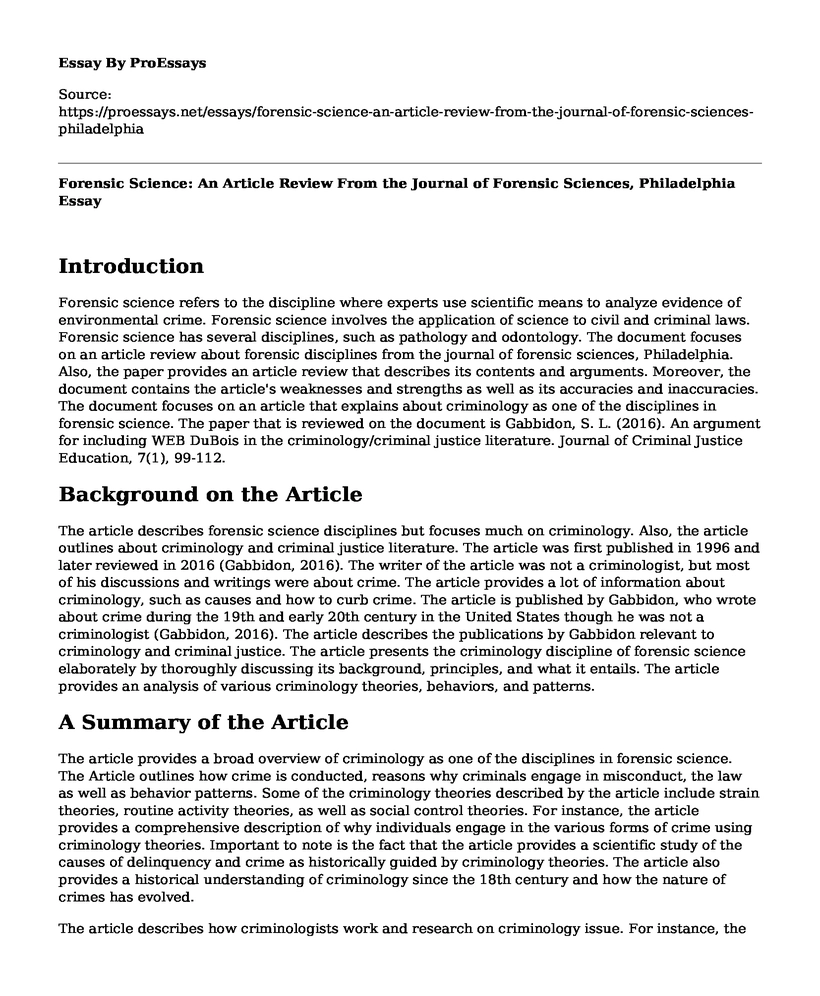Introduction
Forensic science refers to the discipline where experts use scientific means to analyze evidence of environmental crime. Forensic science involves the application of science to civil and criminal laws. Forensic science has several disciplines, such as pathology and odontology. The document focuses on an article review about forensic disciplines from the journal of forensic sciences, Philadelphia. Also, the paper provides an article review that describes its contents and arguments. Moreover, the document contains the article's weaknesses and strengths as well as its accuracies and inaccuracies. The document focuses on an article that explains about criminology as one of the disciplines in forensic science. The paper that is reviewed on the document is Gabbidon, S. L. (2016). An argument for including WEB DuBois in the criminology/criminal justice literature. Journal of Criminal Justice Education, 7(1), 99-112.
Background on the Article
The article describes forensic science disciplines but focuses much on criminology. Also, the article outlines about criminology and criminal justice literature. The article was first published in 1996 and later reviewed in 2016 (Gabbidon, 2016). The writer of the article was not a criminologist, but most of his discussions and writings were about crime. The article provides a lot of information about criminology, such as causes and how to curb crime. The article is published by Gabbidon, who wrote about crime during the 19th and early 20th century in the United States though he was not a criminologist (Gabbidon, 2016). The article describes the publications by Gabbidon relevant to criminology and criminal justice. The article presents the criminology discipline of forensic science elaborately by thoroughly discussing its background, principles, and what it entails. The article provides an analysis of various criminology theories, behaviors, and patterns.
A Summary of the Article
The article provides a broad overview of criminology as one of the disciplines in forensic science. The Article outlines how crime is conducted, reasons why criminals engage in misconduct, the law as well as behavior patterns. Some of the criminology theories described by the article include strain theories, routine activity theories, as well as social control theories. For instance, the article provides a comprehensive description of why individuals engage in the various forms of crime using criminology theories. Important to note is the fact that the article provides a scientific study of the causes of delinquency and crime as historically guided by criminology theories. The article also provides a historical understanding of criminology since the 18th century and how the nature of crimes has evolved.
The article describes how criminologists work and research on criminology issue. For instance, the article outlines how criminologist uses behavioral patterns in finding a particular perpetrator. Moreover, the article describes the role of technology in criminology in a diverse way. Majority of police departments supply their officers with mobile data terminals to help in curbing crime (Ferrell, 2014). Some of the technologies described in the article include video recording, rapid identification, computer-aided dispatch, evidence property reporting as well in-car computers. The article provides a discussion on the importance of embracing technology in dealing with criminals as well as ways of preventing crime.
The article provides an understanding of the specific areas that forensic science and criminology focus on such as types of crimes, government reactions to crime, social responses, and location of crimes as well as social and individual consequences of crime. (Ferrell, 2014). Moreover, the article describes forensic science and criminology on various principles such as positivist and classical principles. Also, the article describes how criminology and forensic science helps in improving society such as increased and more specialized areas of study such as environmental criminology.
The strengths of the article include the ability to provide literature on forensic science through the use of a simple language that can be easily understood as well as providing facts on the topic. Also, the article offers sources to all information and literature within. However, some of the weaknesses of the article is that it fails to explain how forensic science experts and criminologists use technology to identify and prevent crime (Loeber, & Le Blanc, 2010). Also, another weakness of the article is the fact that it does not combine literature from other forensic science journals and articles. However, the article provides specific accuracies, such as giving dates and years while describing the history of criminology.
Conclusion
Conclusively, the article does not provide an elaborate description of the role of information technology in criminology and forensic science. The article has a gap that future researchers can research such as how information technology can be used in crime prevention. The information provided in the article contributes to the forensic science community by providing solutions on how to curb crime as well as how to identify perpetrators.
References
Gabbidon, S. L. (2016). An argument for including WEB DuBois in the criminology/criminal justice literature. Journal of Criminal Justice Education, 7(1), 99-112. Retrieved from https://scholar.google.com/scholar?hl=en&as_sdt=0%2C5&q=Criminology&btnG=#d=gs_cit&u=%2Fscholar%3Fq%3Dinfo%3A3an9XPVpFfcJ%3Ascholar.google.com%2F%26output%3Dcite%26scirp%3D9%26hl%3Den
Ferrell, J. (2014). Cultural criminology (pp. 904-913). Springer New York. Retrieved from https://scholar.google.com/scholar?hl=en&as_sdt=0%2C5&q=Criminology&btnG=#d=gs_cit&u=%2Fscholar%3Fq%3Dinfo%3A3an9XPVpFfcJ%3Ascholar.google.com%2F%26output%3Dcite%26scirp%3D9%26hl%3Den
Loeber, R., & Le Blanc, M. (2010). Toward a developmental criminology. Crime and justice, 12, 375-473. Retrieved from https://scholar.google.com/scholar?hl=en&as_sdt=0%2C5&q=Criminology&btnG=#d=gs_cit&u=%2Fscholar%3Fq%3Dinfo%3A3an9XPVpFfcJ%3Ascholar.google.com%2F%26output%3Dcite%26scirp%3D9%26hl%3Den
Cite this page
Forensic Science: An Article Review From the Journal of Forensic Sciences, Philadelphia. (2023, Jan 26). Retrieved from https://proessays.net/essays/forensic-science-an-article-review-from-the-journal-of-forensic-sciences-philadelphia
If you are the original author of this essay and no longer wish to have it published on the ProEssays website, please click below to request its removal:
- Paper Example on Children's Rights
- The Affordable Care Act: Impacts on Nursing Practice
- Essay Example on "Three Strikes" Law: Criminal Justice and Public Policy
- Case Study of Eric Edgar Cooke
- Essay Example on Social Justice Advocate: 32yo Lady Fights Oppression With Passion
- Essay Example on Foodservice Cost Control: Issues & Recommendations
- Essay Example on Inmate Litigation & Prison Litigation Reform Act: Debunking Protection for Prisoners







